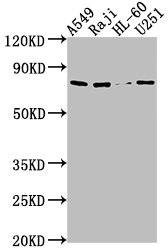RANBP9 Antibody
产品详情
-
产品名称:Rabbit anti-Homo sapiens (Human) RANBP9 Polyclonal antibody
-
Uniprot No.:Q96S59
-
基因名:RANBP9
-
别名:B cell antigen receptor Ig beta associated protein 1 antibody; BPM 90 antibody; BPM L antibody; BPM-L antibody; BPM90 antibody; BPML antibody; IBAP 1 antibody; Imp 9 antibody; Importin 9 antibody; Novel centrosomal protein RanBPM antibody; RAN binding protein 9 antibody; Ran binding protein centrosomal antibody; Ran Binding Protein in the Microtubule organizing center antibody; Ran binding protein M antibody; Ran BP9 antibody; Ran-binding protein 9 antibody; Ran-binding protein M antibody; RANB9_HUMAN antibody; RanBP 7 antibody; RANBP 9 antibody; RanBP7 antibody; RanBP9 antibody; RanBPM antibody
-
宿主:Rabbit
-
反应种属:Human
-
免疫原:Peptide sequence from Human Ran-binding protein 9 protein (158-176AA)
-
免疫原种属:Homo sapiens (Human)
-
标记方式:Non-conjugated
本页面中的产品,RANBP9 Antibody (CSB-PA853501OA01HU),的标记方式是Non-conjugated。对于RANBP9 Antibody,我们还提供其他标记。见下表:
-
克隆类型:Polyclonal
-
抗体亚型:IgG
-
纯化方式:Antigen Affinity Purified
-
浓度:It differs from different batches. Please contact us to confirm it.
-
保存缓冲液:Preservative: 0.03% Proclin 300
Constituents: 50% Glycerol, 0.01M PBS, pH 7.4 -
产品提供形式:Liquid
-
应用范围:ELISA, WB, IHC
-
推荐稀释比:
Application Recommended Dilution WB 1:500-1:2000 IHC 1:20-1:200 -
Protocols:
-
储存条件:Upon receipt, store at -20°C or -80°C. Avoid repeated freeze.
-
货期:Basically, we can dispatch the products out in 1-3 working days after receiving your orders. Delivery time maybe differs from different purchasing way or location, please kindly consult your local distributors for specific delivery time.
相关产品
靶点详情
-
功能:May act as scaffolding protein, and as adapter protein to couple membrane receptors to intracellular signaling pathways (Probable). Acts as a mediator of cell spreading and actin cytoskeleton rearrangement. Core component of the CTLH E3 ubiquitin-protein ligase complex that selectively accepts ubiquitin from UBE2H and mediates ubiquitination and subsequent proteasomal degradation of the transcription factor HBP1. May be involved in signaling of ITGB2/LFA-1 and other integrins. Enhances HGF-MET signaling by recruiting Sos and activating the Ras pathway. Enhances dihydrotestosterone...显示更多
-
基因功能参考文献:
- review provides a complete guide on RanBPM interactors, the physiological role of RanBPM in cellular functions, and potential applications in disease therapeutics. PMID: 29723489
- Ran binding protein 9(RanBPM) is a scaffolding protein with a modulatory function that regulates the activities of IFN-stimulated response elements. IFN-lambda1 affects the cellular distribution of RanBPM and stimulates the interaction between RanBPM and interferon, lambda receptor 1(IFN-lambdaR1). Therefore, RanBPM plays a novel role in the IFN-lambda-regulated signaling pathway. PMID: 28547582
- High RANBPM expression is associated with cancer. PMID: 26919101
- RanBP9/TSSC3 complex cooperatively suppress metastasis via downregulation of Src-dependent Akt pathway to expedite mitochondrial-associated anoikis. PMID: 28032865
- Results show that increased expression of RanBPM associates with postponed disease progression and better prognosis suggesting that RanBPM plays an inhibitory role in regulating proliferation and invasion of lung cancer cells. PMID: 28739732
- The 20-mer peptide (residues 228-247) of human DDX-4, an ATP-dependent RNA helicase known to regulate germ cell development, binds to a unique shallow binding surface on RanBPM formed by highly conserved loops on the surface of the beta-sheet with two aspartates on one end, a positive patch on the opposite end, and a tryptophan lining at the bottom of the surface. PMID: 27622290
- RanBPM acts as a negative regulator of BLT2 and IL8, thus attenuating the invasiveness of aggressive breast cancer cells PMID: 28027932
- RanBP9 absence hampers the molecular mechanisms leading to efficient repair of damaged DNA, resulting in enhanced sensitivity to genotoxic stress. PMID: 26943034
- Loss of RanBPM expression may play an important role in gastric cancer tumor development and metastasis. Reduced RanBPM expression is also associated with chemoresistance of gastric cancer cells. PMID: 26977028
- RanBP9 is positively expressed in bone tumor tissues and cell strains. PMID: 27049080
- RanBPM was found to enhance Zta-dependent transcriptional activity via the inhibition of Zta sumoylation. PMID: 25900136
- association analyses between RANBP9 variants and the risk of schizophrenia were conducted, however no significant association was identified. PMID: 25482375
- RanBP9 relocates APP intracellular domain to Tip60-enriched nuclear speckles and prevented the formation of nuclear spots formation; results place RanBP9 as an important player in the multiple steps of AbetaPP signaling PMID: 25024339
- these analyses reveal that RanBPM subcellular localization results from the combined effects of several elements that either confer direct transport through the nucleocytoplasmic transport machinery PMID: 25659156
- RanBP9 transgene overexpression causes early synaptic deficits, impaired learning and accelerates amyloid plaque accumulation. PMID: 24254706
- COPS5 is a novel RanBP9-binding protein that increases APP processing and Abeta generation by stabilizing RanBP9 protein levels PMID: 23926111
- RanBPM acts as a negative regulator of BLT2 signaling to attenuate BLT2-mediated cell motility PMID: 23928309
- RanBPM influences TRAF6 ubiquitination and the TRAF6-triggered NF-kappaB signaling pathway through RanBPM's interaction with TRAF6. These data suggest that RanBPM participates in gene transcription by binding to TRAF6. PMID: 21805090
- Data indicate that RanBP9 simultaneously inhibits cell-adhesive processes and enhances Abeta generation by accelerating APP, LRP, and beta1-integrin endocytosis. PMID: 22223749
- results indicate that RanBPM, potentially through interaction with citron kinase, plays a role in the progression of neocortical precursors through M-phase at the ventricular surface. PMID: 19790105
- RanBPM co-localizes with p42IP4 and, together with p42(IP4), the SPRY domain of RanBPM could act as a modulator of synaptic plasticity. PMID: 18298663
- data support the idea that RanBP9 and RanBP10 may function as signaling integrators and dictate the efficient regulation of D(1) receptor signaling by PKCdelta and PKCgamma PMID: 20395553
- RanBPM may modulate TrkB-mediated downstream signaling and biological functions. PMID: 20403074
- These results reveal a novel proapoptotic function for RanBPM in DNA damage-induced apoptosis through the regulation of factors involved in the mitochondrial apoptotic pathway. PMID: 19996306
- RanBP9-N60, a processed form of RanBP9 virtually identical to the RanBP9-Delta1/N60 mutant, was strongly increased in Alzheimer disease brains compared with controls. PMID: 19729516
- RanBPM is the enzymic substrate for USP11 and is deubiquitinated specifically PMID: 12084015
- RANBPM has a role in the HGF-MET and Ras signal transduction pathways PMID: 12147692
- overexpressed wildtype HIPK2 and a kinase defective mutant of HIPK2 directly interact with RanBPM in the nucleus of mammalian cells. PMID: 12220523
- interacts with steroid receptors to selectively modify their activity PMID: 12361945
- demonstrates that CDK11(p46) directly interacts with RanBPM in vitro and in human cells PMID: 14511641
- RanBPM may constitute a molecular scaffold that contributes to coupling LFA-1 and other integrins with intracellular signaling pathways PMID: 14722085
- Expression of RanBPM inhibited the ubiquitination of p73alpha, and thereby prolonged its half-life. PMID: 15558019
- Results identify and characterise a novel interaction between RanBPM and the related receptor tyrosine kinases, Axl and Sky. PMID: 15964779
- Coexpression of RANBP9 with constitutively active Raf kinase synergistically inhibited myogenic regulatory factor MyoD-directed muscle reporter gene transcription PMID: 16364241
- CD39 associations with RanBPM have the potential to regulate NTPDase catalytic activity. This intermolecular interaction may have important implications for the regulation of extracellular nucleotide-mediated signalling. PMID: 16478441
- RanBPM is a potent novel coactivator for thyroid hormone receptors PMID: 16595702
- RanBPM, ARMC8alpha, ARMC8beta, Muskelin, p48EMLP, and p44CTLH form complexes in cells PMID: 17467196
- Studies in this review indicate that RanBPM acts as a scaffolding protein and is important in regulating cellular function in both the immune system and the nervous system. PMID: 18040864
- Results describe the enhancement of the transactivation activity of Epstein-Barr virus Rta protein by RanBPM. PMID: 18455188
- These novel findings identify a role for muskelin-RanBP9 complex in pathways that integrate cell morphology regulation and nucleocytoplasmic communication. PMID: 18710924
- These results suggest that RanBPM could be a key regulator of Ca(v)3.1 channel-mediated signaling pathways. PMID: 18801335
- Overexpression of RanBP9 resulted in the enhancement of APP interactions with LRP and BACE1 and increased lipid raft association of APP. PMID: 19251705
收起更多
-
亚细胞定位:Cytoplasm. Nucleus. Cell membrane; Peripheral membrane protein.
-
蛋白家族:RANBP9/10 family
-
组织特异性:Ubiquitously expressed, with highest levels in testes, placenta, heart, and muscle, and lowest levels in lung. Within the brain, expressed predominantly by neurons in the gray matter of cortex, the granular layer of cerebellum and the Purkinje cells.
-
数据库链接:
HGNC: 13727
OMIM: 603854
KEGG: hsa:10048
STRING: 9606.ENSP00000011619
UniGene: Hs.708182























